by Todd Rutherford
After a long hot summer in Colorado, the fall season may seem like a time to forget about your yard or garden and start focusing your attention indoors. But fall is a great time for some low-water perennial plants to look their best and shine in your xeriscape garden. The following list of plants take center stage during the fall season, and keep your landscape looking great beyond the arrival of the autumnal equinox.
Anemone (various species and cultivars)
Anemones are a great plant for the shadier areas of your landscape. While not as drought tolerant as the other plants on this list, they grow very well with afternoon shade and a medium amount of water.
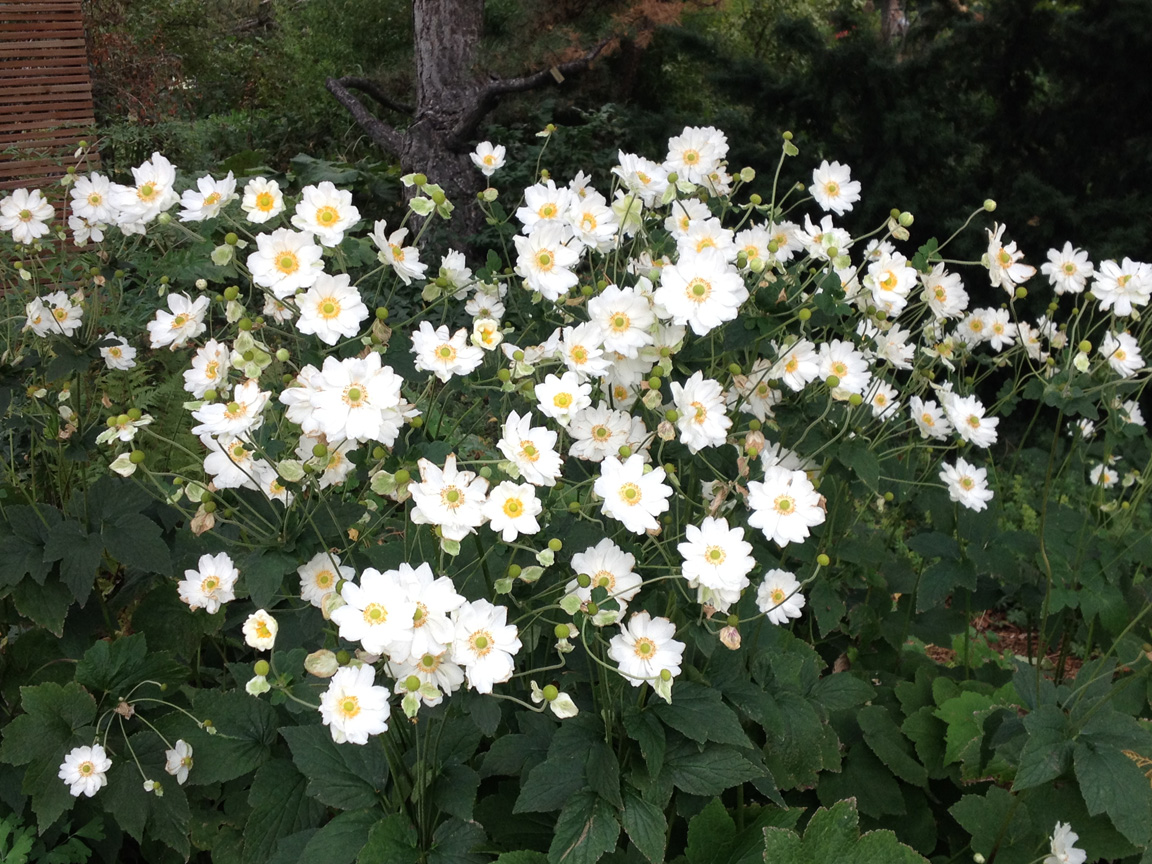
Anemone
Tall Sedums, various cultivars
The tall sedums are a classic addition to the fall blooming garden. With low to average water needs, they are perfect for most xeriscape gardens.
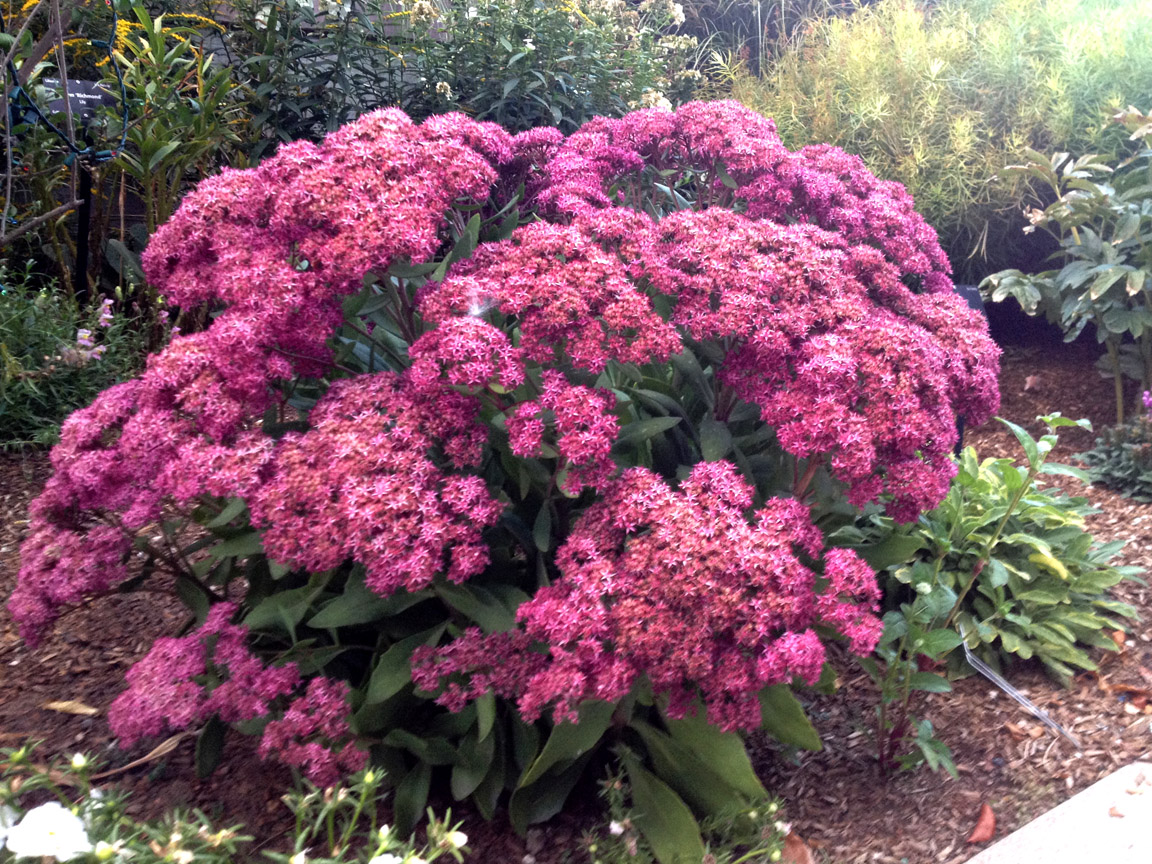
Sedum
Hummingbird Flower, Epilobium canum latifolum (aka Zauschneria canum latifolium)
This cousin of the popular groundcover plant Orange Carpet California Fuschia (also a good late bloomer) has similar dazzling orange trumpet shaped flowers that pollinators adore.
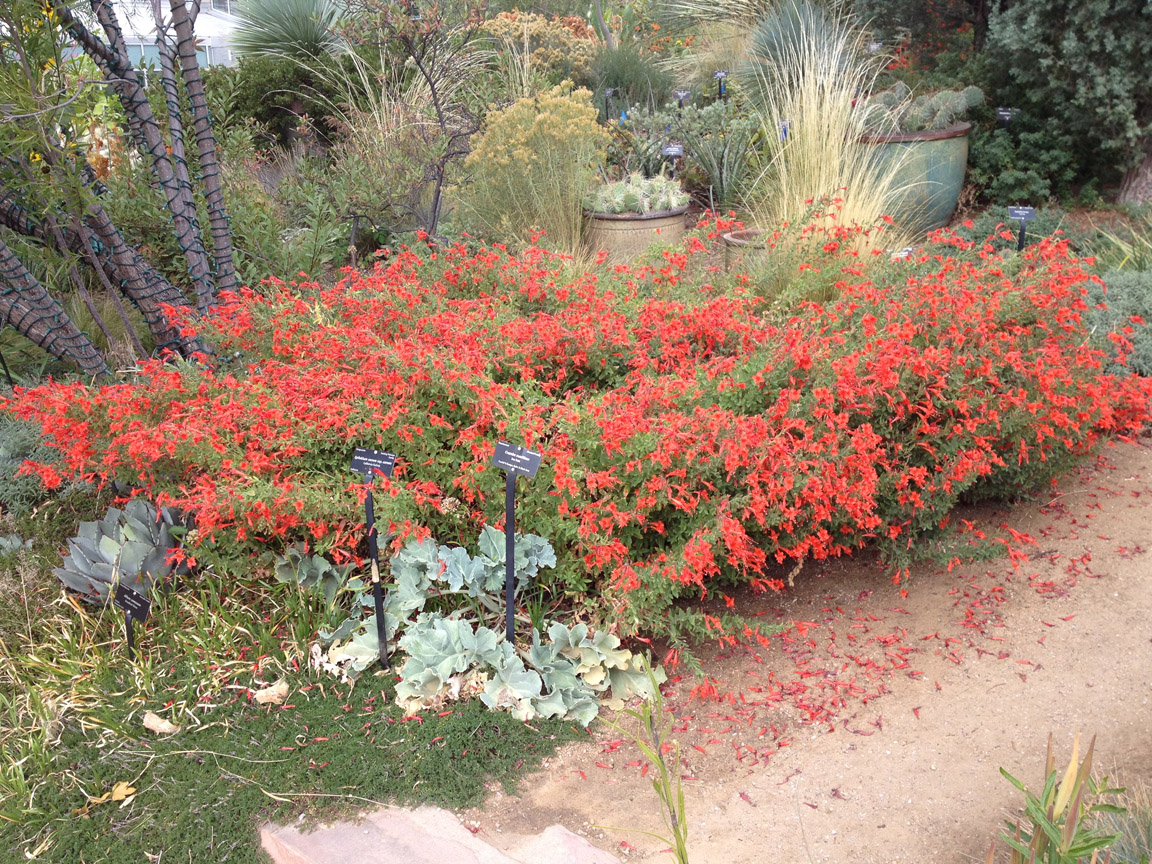
Hummingbird Flower
Furman’s Red Salvia, Salvia greggii (several species and cultivars available in the Salvia genus)
There are so many different and wonderful plants in the Salvia genus that are remarkable additions to your low-water landscape. Furman’s Red Salvia is one plant we have raved about many times, and it never fails to keep us captivated by its lovely and numerous red blooms that drape these plants from summer heat to fall frost. One note of caution on this plant would be the hardiness. It is rated as only hardy to zone 6, so be careful where you place it. A warmer micro-climate location in your landscape would be best.
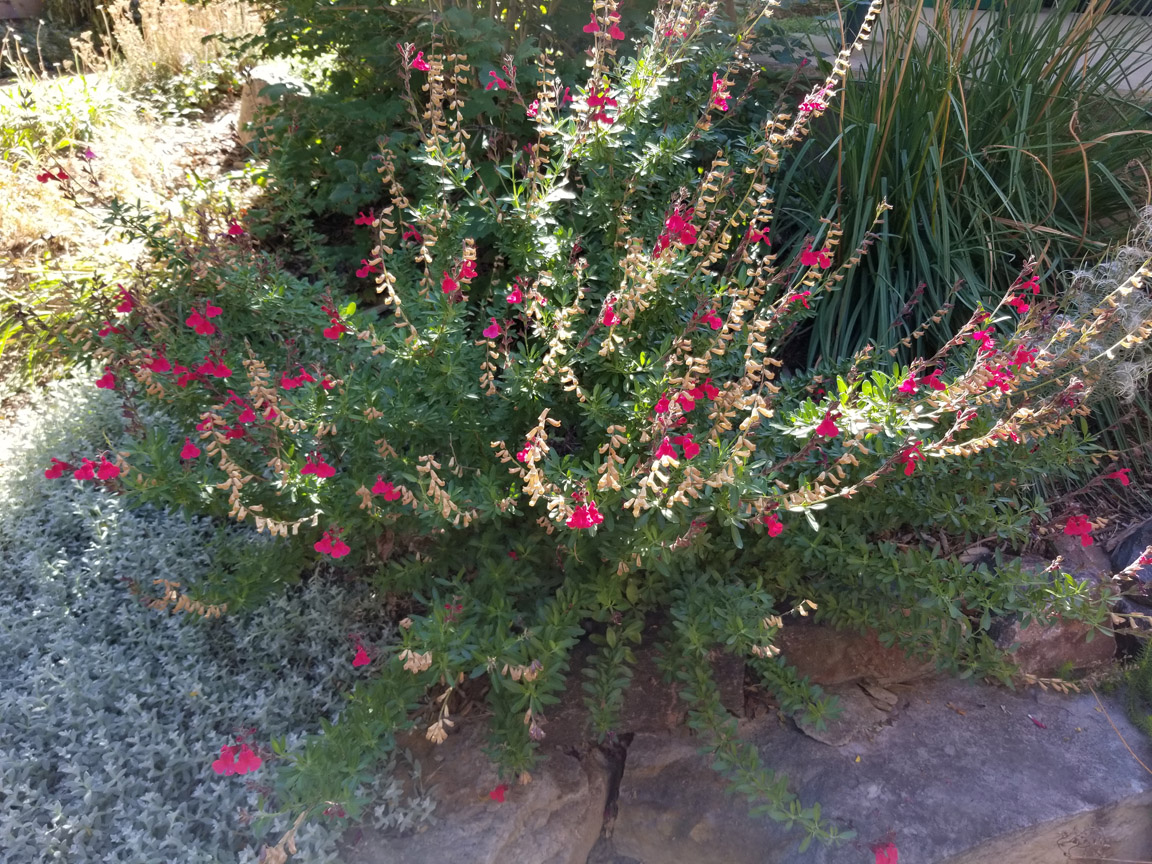
Furman’s Red Salvia
Blanket flower, Gaillardia (various cultivars available)
While the blanket flowers bloom more profusely in the heat of the summer, they continue to bloom into fall, bringing their brilliant shades of yellow, orange and red into the shorter days of autumn.
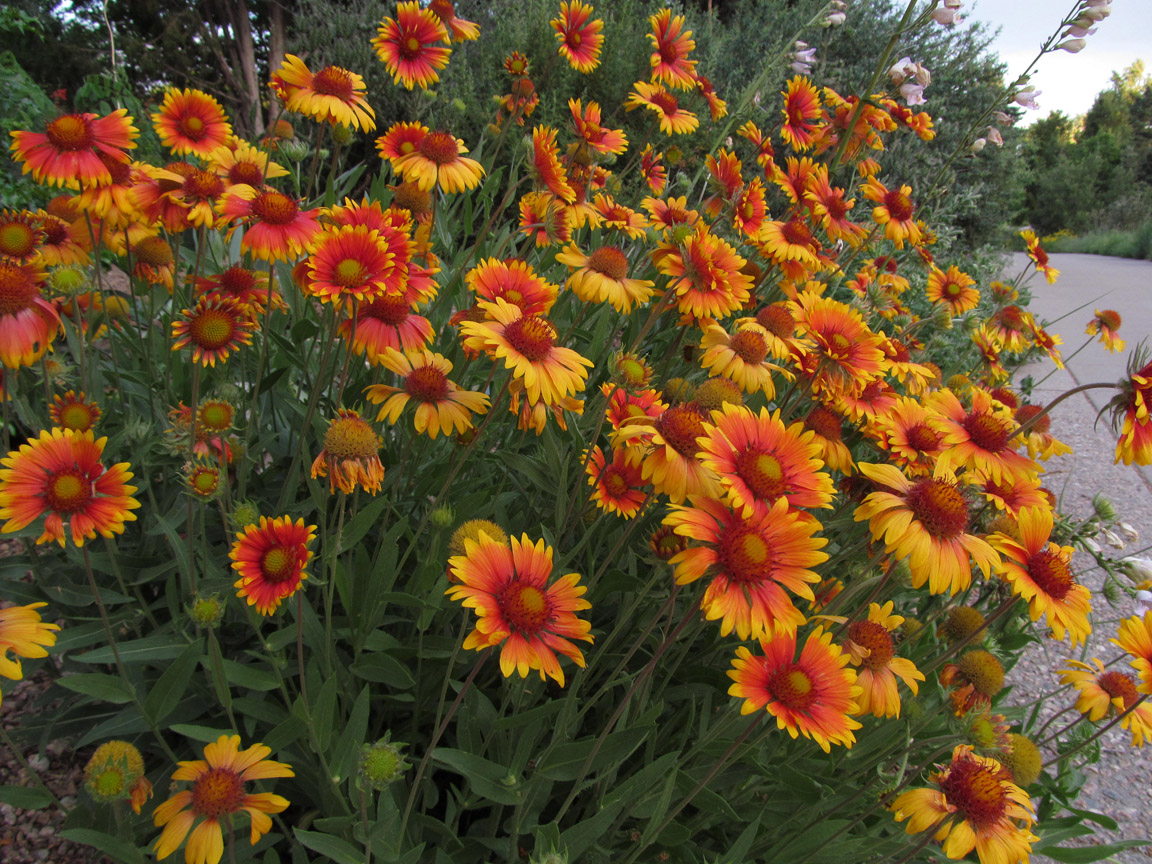
Blanket Flower
Goldenrod, Solidago (various species)
Solidago rugosa ‘Fireworks’ is the plant pictured here. Who wouldn’t mind this kind of fireworks in their fall landscape? This North American native will grace your garden with many panicles of bright yellow flowers. While not as tolerant of drought as some other plants on this list, it is fairly adaptable to most conditions in Colorado. This plant has been unfairly blamed for hayfever and allergies in the past, but scientists now tell us that Goldenrod is not the cause of your fall allergies. It is likely caused by other plants such as ragweed.
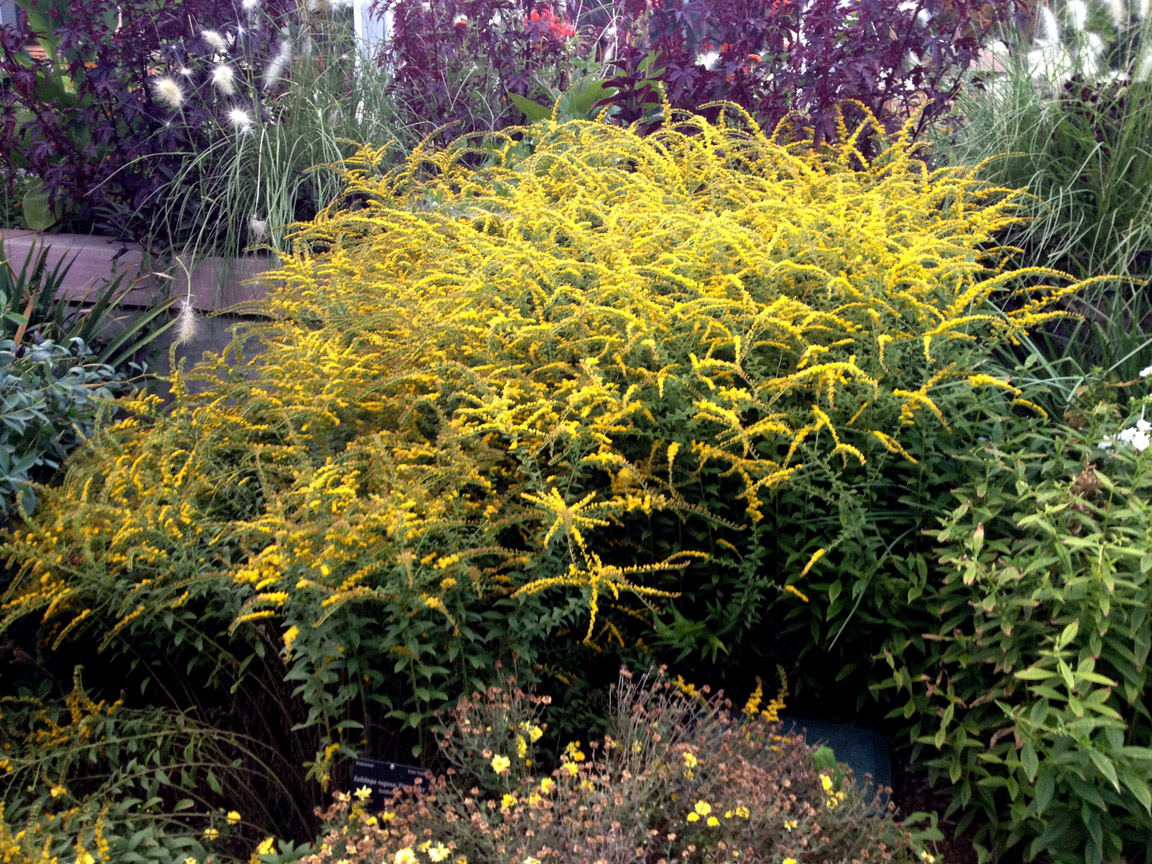
Goldenrod
Plumbago, Ceratostigma plumbaginoides
Plumbago is an indispensable groundcover. It does well in dry shade, and that is the type of conditions we typically place it in. However, we are finding it seems to be adaptable to sunnier locations as well. The blue-violet flowers that appear on this plant in late summer are eye-catching, as is the red-orange fall color of the foliage as autumn grows cooler.
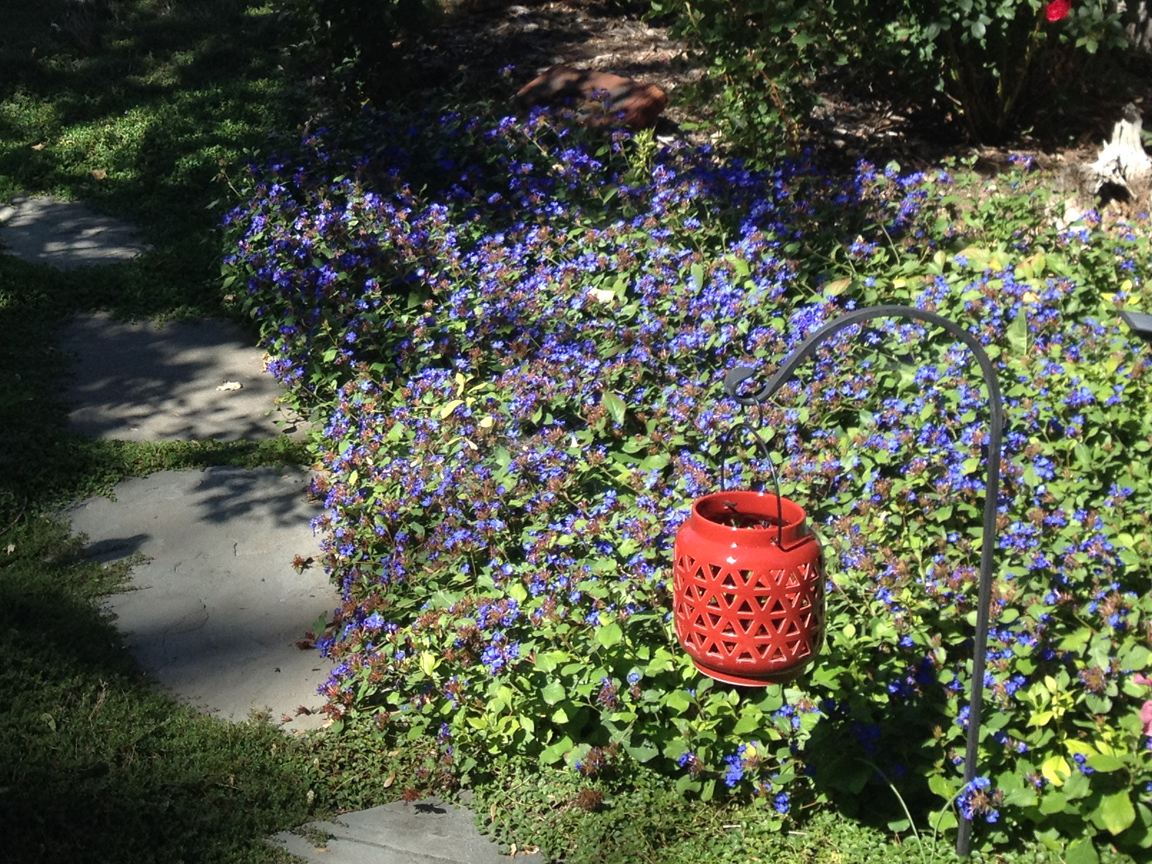
Plumbago
This is the official blog of Outdoor Design Group, Colorado Landscape Architects. For more information about our business and our services, click here.
Related Posts:
by Todd Rutherford
The landscaping on commercial sites may be low on a business owner’s list of priorities for their property. But you should not underestimate the positive influence an attractive landscape can have on potential clients. With this in mind, here is a list of ten issues to consider for choosing the right plants to keep your property’s landscaping looking and functioning at its best.
Non-Invasive
Some very hardy plants would be great choices for commercial landscapes if not for their tendency and ability to invade and spread where they are not wanted. This may happen via seedlings or by creeping rhizomes (horizontal underground stems that can send out new roots and shoots). Luckily, here in Colorado and the Inter-Mountain West, our growing climate is challenging for many invasive plants that have ravaged milder climates in North America. However, there are some plants you should never allow to take root in Colorado due to their invasive nature. For a list of plants see: http://www.invasivespeciesinfo.gov/unitedstates/co.shtml; http://www.ext.colostate.edu/ptlk/2041.html
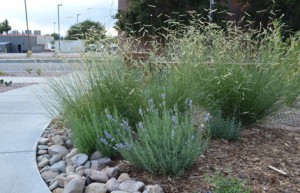
Blonde Ambition Grama Grass and English Lavender
Disease Resistant
Nobody wants to spend extra money or time dealing with or replacing diseased or dying plants. Avoid choosing plants that are easily susceptible to attack from disease or pests.
Long Lived
Along the same lines of replacing diseased plants prematurely, nobody wants to spend time and money replacing plants that live short lives. The cost of purchasing and installing landscape plants is significant, so it is wise to choose plants that will stand the test of time.
Adaptable to various exposures
The location you are planting on your property may currently be in any degree of exposure from full sun to full shade. But conditions may change in the near future. Will a new building or new trees be placed on the neighboring property? Conversely is a structure or tree slated to come down, creating a new pocket of full sun? Picking plants with higher adaptability to various exposures will ensure success for your landscape.
Adaptable to various soils
The soils in my area are typically heavy in clay with a high (alkaline) pH. This is one more challenge to add to the list of issues that face landscape plants. For best success and longevity, choose plants adapted or adaptable to the soil conditions on your property.
Adaptable to variable moisture levels
You may be familiar with desert plants and you may be familiar with rainforest plants. These two extremes of ecology illustrate the wide variability of climate that plants live in. Your landscape likely falls somewhere in between these extremes. However, even in the most average commercial landscape, we might find wide degrees of moisture and irrigation levels. Having plants that can handle these extremes will help ensure your landscapes do well.
Drought Tolerant
Although nearly all municipalities require automatic landscape irrigation, it is good if the plants you specify for a site are truly drought tolerant.
But on the flip side, some plants that are considered very low water plants may be more difficult to establish on a commercial site due to over watering. Many but not all native plants fall in this category. They are more fussy about soils and drainage. They may need to be ruled out of the “set it, and forget it” situation that many commercial clients may seek. But if you have the time or the staff to work with some very low water plants during their establishment time, they can eventually become great components of your drought tolerant landscaping. The easiest plants to use in your landscape will be adaptable to varying soil moisture levels.
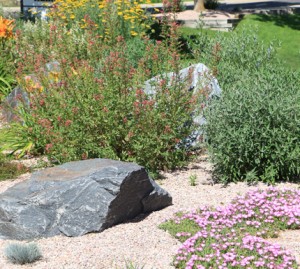
A variety of perennials and shrubs adapted to Colorado’s climate.
Not messy or difficult to maintain
Your maintenance crew has enough on their plate with regular landscape maintenance. There’s no reason to increase their burden and your costs by having messy, difficult plants on your property.
Readily available from nurseries (not rare)
If you lose some of your landscape plants due to accidents, vandalism or bad weather, you will likely want to easily replace the missing vegetation. If the plant that needs to be replaced is hard to find, you might have to resort to replacing it with one that does not match.
Attractive/Interesting/Eye-catching
Attract eyeballs and attention to your business by choosing interesting trees, shrubs and flowering plants. Just as having aesthetically pleasing buildings or signage is good for business, eye-catching vegetation and other landscape elements makes good business sense. Choose Trees and shrubs with notable flowers or good fall color.

A Hawthorne tree in spring bloom.
In Summary
If you are planning a new commercial landscape or taking an assessment of your existing commercial landscape, keep these guidelines in mind. They’ll help you avoid potential problems that might repel clients and customers from your property, rather than inviting them in. An inviting landscape on your commercial property is one of the first steps to achieving business success.
This is the official blog of Outdoor Design Group, Colorado Landscape Architects. For more information about our business and our services, click here.
Related Posts:
by Todd Rutherford
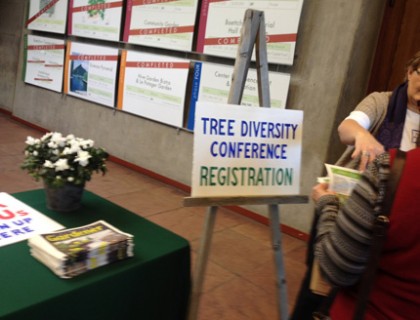
Attendees in the lobby of the Denver Botanic Gardens where the Tree Diversity Conference was held.
This past Spring, tree enthusiasts from around the region gathered at the Denver Botanic Gardens to listen and learn from various presenters on the theme of Tree Diversity for Colorado. It seems recent crises such as the discovery of Emerald Ash Borer infestation in Boulder has revealed the urgency for members of the Green Industry to seek out more hardy and appropriate tree species for our region. There are other reasons to seek out trees better adapted to our climate. As climate scientists continue to inform us, it is likely that Colorado’s climate will get warmer and drier, providing even more challenging growing conditions for trees. Also, biotic mixing will continue to increase as more people move goods and materials far and wide across the globe. That is the most probable scenario of how EAB was found in Boulder: it was brought there in a wooden crate shipped from Asia. What far-flung exotic pest will next appear in our area?
This year’s conference was the second occurrence of such a gathering in Denver. Several new tree species were presented to the audience, along with some old stand-bys, with a discussion of each tree’s merits.
Although there were several genera that are represented in the group of trees, the two genera with the most candidates are Maples and Oaks. The other genus with multiple species that should get wider consideration for planting in our area is Ulmus (elms). While most elms have been looked over because of Dutch Elm Disease and also the invasive nature of Siberian Elm (Ulmus pulmila), there are a few cultivars that we should consider planting in Denver.
Here are ten trees that were discussed at the conference (out of many others) that you might consider planting in Colorado and the surrounding region:
Acer grandidentatum ‘Manzano’ – Manzano Bigtooth Maple Ht: 20-30’ Wd: 20-30’
Large shrub or small tree with rounded form. The Manzano is a more tree like form of bigtooth maple. Once established, the bigtooth maples are drought tolerant.
Acer miyabei ‘Morton’ – State Street Maple Ht: 50’ Wd: 35’
Rough corky bark and leaf shape are similar to Hedge Maple, but its stronger growth rate and ascending branch habit result in a larger mature size. Excellent drought and cold tolerance. Very adaptable.
Acer saccharum ‘Collins Caddo’ – Collins Caddo Sugar Maple Ht: 45’ Wd: 40’
This maple provides red fall color, but unlike a red maple like Autumn Blaze (Acer x freemanii), the sugar maples are more adapted to the alkaline soils of Colorado’s Front Range urban corridor.
Acer tataricum ‘JFS-KW2’ – Rugged Charm Maple Ht: 28’ Wd: 15’
Compact oval form. More upright than the popular Hot Wings Tatarian maple.
Quercus macrocarpa ’Bullet Proof’ – Bullet Proof Bur Oak Ht: 50-80’ Wd: 50-80’
This large oak sports a massive trunk, deeply furrowed, that supports corky ridged twigs on spreading branches that makes for a broad and rounded canopy. This variety is more resistant to the galls that can affect other Bur Oaks.
Quercus muehlenbergii – Chinkapin Oak Ht: 40’ Wd: 40’
A durable and adaptable oak with narrow lustrous glossy dark green leaves and an open, irregular, rounded habit. Prefers well drained soil.
Quercus robur x alba ‘JFS-KW1QX’ – Streetspire Oak Ht: 45’ Wd: 14’
Dark green leaves of this narrowly columnar tree are mildew resistant. Turning red in autumn, they fall to reveal stiffly upright branches. Similar to Crimson Spire, but does not hold brown foliage through the winter
Ulmus davidiana – David Elm Ht: 40’ Wd: 30’
Medium sized tree, with vase shape. Resistant to Dutch elm disease.
Ulmus propinqua ‘JFS-Bieberich’ – Emerald Sunshine Elm Ht: 35’ Wd: 25’
Grown from seed collected in China, this sturdy, upright-growing elm was selected for superior performance on the hot, arid, windswept plains of western Oklahoma. Handsome, deeply corrugated leaves emerge coppery-bronze and mature to glossy green.
Ulmus japonica x wilsoniana ‘Morton’ – Accolade Elm Ht: 70’ Wd: 60’
Arching limbs and a graceful vase shape (similar to the American elm) characterize this hybrid elm selected and tested at Morton Arboretum. Glossy, dark green foliage changes to yellow in the fall and is resistant to elm leaf beetle feeding.
This is the official blog of Outdoor Design Group, Colorado Landscape Architects. For more information about our business and our services, click here.
Related Posts:
by Todd Rutherford
As gardeners in Colorado may well know, our climate and altitude make for challenging growing conditions. This doesn’t mean we are completely immune from invasive exotic plants making an unwelcome home here. We do not have the burden that gardeners in wetter and warmer states may have at stopping the spread of invasive plants, but there are a few species you should be aware of so you can help stop these unwanted guests from gaining a foothold in our landscapes.
Why be concerned about invasive plants? They crowd out native plants, propagate uncontrollably, and may reduce forage for wildlife. Some may have a negative impact on your garden plants. And research suggests that some invasive species may pose dangers to humans through the increased risk of flooding due to damaged waterways, or increased fire danger.
The two worst invasive woody plants for Colorado and the surrounding region are the Russian Olive and the Tamarisk. Russian Olive (Elaeagnus angustifolia), is native to western and central Asia. It was introduced into North America in the latter part of the 1800’s. It is not related to true olive plants (Olea europaea) but its fruit is edible but not very palatable for human consumption. It out competes native plants because its seeds are irresistible to birds which spread the seeds far and wide. The seeds have a low mortality rate, germinate readily in poor soil (it can fix its own nitrogen in its roots), reach maturity quickly and thus outcompete native plants. In Colorado, they often begin setting a foothold in riparian areas, and then spread from there.
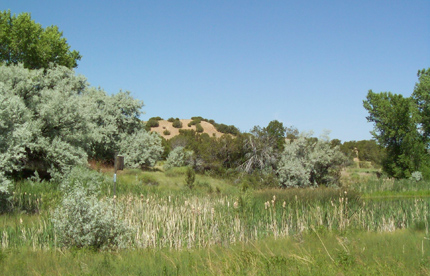
Russian Olives invading a wetland in New Mexico.
Tamarisk (Tamarix ramosissima), which is more of a shrub than a tree, similarly starts its spread in the riparian areas of the Colorado and other southwestern states. It has been such a successful invader of wet areas, that it has overtaken huge sections of the rivers of the southwest. However, it is not as tolerant of cold temperatures as is Russian Olive, which restricts its spread to the warmer, lower elevations of the southwest. Tamarisk is tolerant of many soil types, and thrives in full sun. One of the concerns about Tamarisk’s effect on native landscapes is how they out compete native vegetation, altering the nutrient cycles of riparian areas. They also consume large amounts of water, and secrete large amounts of salt, both items further slowing the success of nearby native plants. A massive amount of resources and manpower are being directed at the fight to stop the spread of this plant through the wildlands of the desert southwest.
…the Siberian Elm is “one of, if not the, world’s worst trees…a poor ornamental that does not deserve to be planted anywhere”.
Closer to Denver and the urban areas of Colorado’s front range, there are two trees that are common pests. These are the Siberian Elm (Ulmus pumila), and the Tree of Heaven (Ailanthus altissima). Both of these trees release a profuse amount of seeds, and these seeds are very adept at sprouting in disturbed areas. They proliferate along transportation corridors and abandoned lots. Both trees prefer full sun, but Ailanthus can tolerate some shade allowing it to invade some mature native forests.
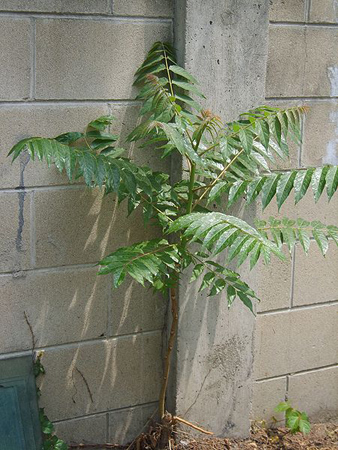
Young Ailanthus altissima
Although not directly related, Ailanthus trees (a.k.a. Tree of Heaven) are often mistaken as sumacs. In springtime they produce many flowers that have a foul odor which some say is similar to cat urine. It rapidly out competes other tree species, releasing an allelopathic chemical which inhibits the growth of other plants. Some researchers have extracted this chemical from Ailanthus trees, successfully using it as an herbicide. Not only is this tree toxic to other plants, there have been anecdotal reports of it being slightly toxic to humans and livestock. Ailanthus trees can grow quite rapidly, leading to weak, unstable branches.
Siberian Elms also have structural problems, with many weak or dead branches that can break off in heavy wind. Siberian elms have a short dormancy period which leads to early flowering in spring, and late leaf drop in fall. In Colorado that means they can become dangerously loaded with wet snow in our common heavy spring snowstorms, or the occasional fall snowstorm, leading to heavy branches falling on roofs and vehicles. In addition to the dangers of breaking limbs, the trees do not have a very favorable appearance, with an awkward branching pattern. One doesn’t need to search too long before you find many Siberian elm seedlings sprouting up in unwanted spots in the urban landscape. The sprouts show up in shrub beds where they are difficult to remove by hand and hard to spray with herbicides without damaging neighboring desired plant materials. Siberian elms are susceptible to damage from elm leaf beetles which leave the leaves looking skeletonized, but it doesn’t seem to kill the trees. Notable horticulturalist Michael Dirr says the Siberian Elm is “one of, if not the, world’s worst trees…a poor ornamental that does not deserve to be planted anywhere”.
To be fair, I should mention that some people look favorably upon these four tree species, and say that in Colorado’s high desert climate (that is naturally and predominantly tree-less east of the Rocky Mountains), an invasive tree is better than no tree, especially in urban areas. I would beg to differ, noting that these trees are too difficult to control and remove, to the detriment of native flora and fauna. Please become aware of these invasive trees and be considerate about whether you want to allow these in your landscape.
This is the official blog of Outdoor Design Group, Colorado Landscape Architects. For more information about our business and our services, click here.
Related Posts:
by Todd Rutherford
I wanted to revisit Matt’s post on the 20 Best Xeriscape Plants for Colorado, and add to his list of great low-water plants for Colorado landscapes. As with Matt’s initial posting, this list of plants also offers a great variety of color, texture and form for your water-wise garden. Consider adopting some of these amazing plants into your landscape, and tell all your friends about the benefits and beauty of drought tolerant plants.
Perennials:
- Chocolate Flower – Berlandiera lyrata An intoxicating chocolate scent emanates from the yellow blooms of this low water southwestern wildflower from summer into fall.
- Whirling butterflies – Gaura lindheimeri Whirling Butterflies truly lives up to its name. Growing 2-3’ tall by 18-24” wide, this perennial has a significant bloom time, sporting multiple flower stalks that whirl numerous small white flowers in the late summer breezes.
- Creeping Veronica – Veronica spp. A spring blooming favorite, creeping veronicas are somewhat adaptable to light and moisture conditions. The deep green foliage is often evergreen in winter and makes a nice backdrop to the abundant light blue to purple flowers that arrive in April.
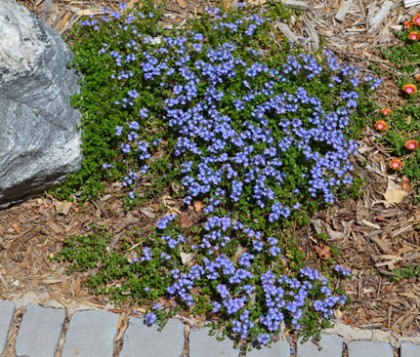
Creeping Veronica
- Sweet Woodruff – Gallium odoratum No dry shade garden should be without this fabulous groundcover. If you have a dry shady spot under a tree, this is the plant for you. It is said that sweet woodruff is one of the few plants that will flourish under the shady canopy of evergreen trees. Small bright green leaves become decorated with tiny white flowers in late spring.
- Orange Carpet Hummingbird Flower – Epilobium canum garrettii If hummingbirds pass through your area consider this California native. It provides a stunning orange floral display in late summer that hummingbirds love, and is ideal to let cascade down a rock wall.
- Blanketflower – Gaillardia aristata Related to sunflowers, this is another North American native that is a great addition to the low-water garden. It blooms from June to September with flower petals that transition from yellow to orange to red. Many cultivars available. Easy to start from seed.
- Silvery Horehound – Marrubium rotundifolium This native of Turkey is a great xeriscape ground cover. It grows 2-4” high and 2-3’ wide. Soft white hairs on the round leaf margins add an effulgent look to the plant.
- Hens and Chicks – Sempervivum spp. This familiar garden succulent from Europe is a hardy performer that will grow just about anywhere. Great for the small spots between other low perennials or rock gardens in full sun. Another nice benefit is how easy it is to transplant the offshoots they provide. Several types are available, with some covered in charming white hairs.
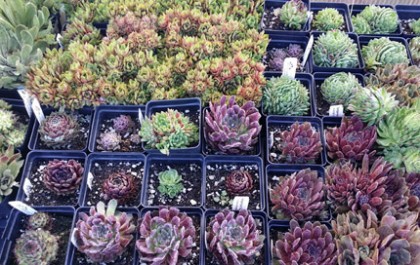
Variety of Sempervivum, a.k.a. Hens and Chicks
- Sunrose – Helianthemum This hardy low-growing perennial provides a delightful floral display starting in June. The profuse blooms hover over a thick mass of low branches that carry small, oval shaped leaves. The flower color is available in shades of red, orange, yellow, pink and white. Perfect for a rock garden or a hot and sunny border area.
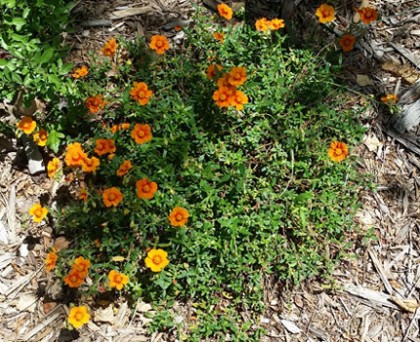
Orange Sunrose
Grasses:
- Blonde Ambition – Bouteloua gracilis ‘Blonde Ambition’ This is a wonderful medium sized grass, 30-36” high and 30-36” wide. It provides multiple seasons of interest, showcasing the classic blue grama grass curled seed heads well into winter.
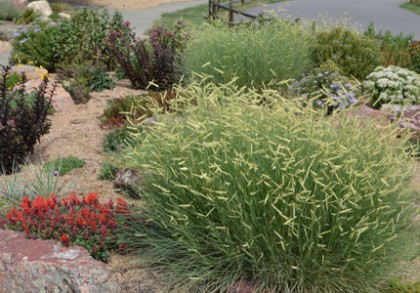
‘Blonde Ambition’ Blue Grama Grass
- ‘Undaunted’ Ruby Muhly – Muhlenbergia reverchonii A 2014 Plant Select introduction. Discovered by Lauren and Scott Ogden, it hails from Oklahoma and Texas. The inflorescence (aka flower cluster) is composed of clouds of tiny pinkish flowers, creating a pink glow with back lighting.
Shrubs:
- Currant – Ribes spp. Currants are medium sized shrubs that grow well in sun, and some species also grow well in filtered shade. This is a notable fact, as many shrubs that do well in part shade require more water than the currants do. Some species provide edible fruit, and some have fragrant flowers. The most notable fragrant currant is Crandall Clove Currant, whose flowers do indeed smell like cloves.
- Dwarf Russian Almond – Prunus tenella Native to Eurasia, this flowering shrub is said to be hardy to zone 2!!! Abundant with pink flowers in the spring, one disadvantage of this shrub is the aggressive suckering habit which may make it hard to control, but this also makes it an attractive cover for wildlife. Size is 3-5’ x 3-5’.
- Dwarf Pinyon Pine – Pinus edulis This slow growing selection of pinyon pine was introduced by Plant Select in 2014. Grows 20-30” height by 20-30” width in 10 years.
- Mohican Viburnum – Viburnum lantana ‘Mohican’ Another great low water shrub that does well in either full or part sun, this viburnum grows 6’ by 6’. White flowers in spring precede orange to red fruits that darken to black in fall.
- Mountain Mahogany – Cercocarpus spp. This western native is indispensable if you’re planning on creating a large native style landscape. Some species are semi-evergreen and one species Cercocarpus montanus the leaves turn a nice russet color in fall. Seeds provide a charming fuzzy appearance that looks great when backlit.
- Peashrub – Caragana spp. A tough shrub from Siberia and China, the peas shrub is, just as the name indicates, related to peas. It produces edible (but not palatable) pods and edible yellow flowers that interest to salads. There are several different species and cultivars to choose from, which range in size from medium to large.
Trees
- Bigtooth Maple – Acer grandidentatum Native to the inter-mountain West, and closely related to the sugar maple. Often growing as multi-stem, it likes full sun to partial shade and low to medium water. The samaras, or winged seeds turn rose color in late summer, and the fall foliage ranges from yellow to red. Grows 20-30’ high by 20-30’ wide.
- Desert Willow – Chilopsis linearis Another typically multi-stem small tree, it is hardy to zone 7 (0 to 5 deg F), but usually survives Denver winters, dying back to the ground each winter, and quickly sprouting new growth each summer. If given a sheltered spot, it may not die back to the ground. Distinctive pink to burgundy flowers with yellow throats. Drought tolerant, with watering being deep and infrequent. Grows 6-30’ high by 6-30’.
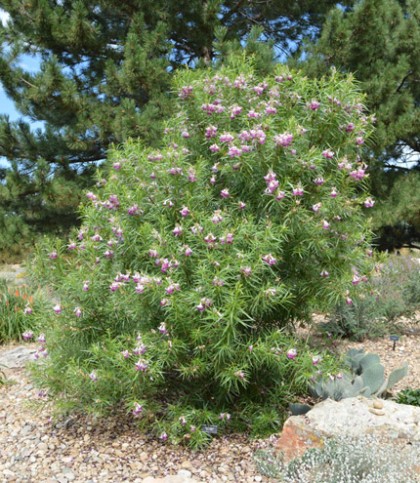
Desert Willow
- Hawthorn – Crataegus spp. These flowering trees are cousins of roses, and bloom in spring with clusters of white flowers that produce long lasting red fruits that offer winter interest. Several species and cultivars have thorns on the branches. Grows 15-25’ high by 15-25’ wide, depending on species and cultivar.
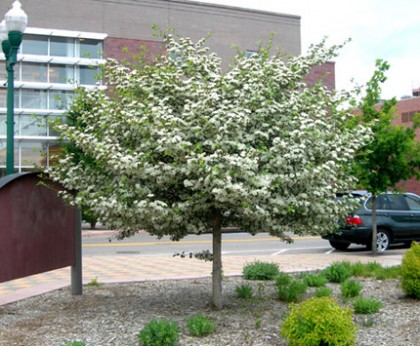
Hawthorn
The Criteria for this List:
– This list is for the Front Range of Colorado. We are somewhere in the middle of zone 4 to 5 on the USDA Plant Hardiness Zone Map.
– I have only included plants that are very easy to care for, and have excluded plants that require a lot of water since that is a key component of Xeriscape. The “best” plants, in my opinion, are those that are well adapted to the local climate and do not require much additional water and maintenance. Of course there are occasions where the use of higher water-use plants is desirable, such as in drainage areas, however I have left them off of this particular list.
This is the official blog of Outdoor Design Group, Colorado Landscape Architects. For more information about our business and our services, click here.
Related Posts:



















